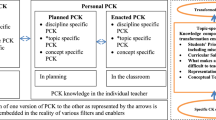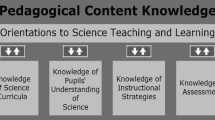ABSTRACT
A crucial issue for prospective teachers (PTs) in their education is to develop pedagogical content knowledge (PCK; i.e. how to make a topic comprehensible to pupils). However, research has shown that PTs may have tacit ideas about teaching that act as filters preventing consideration of unfamiliar and discrepant ideas. These ideas must be elicited and taken into consideration in order to be modified. Therefore, PTs’ explicit conceptions may constitute a valuable resource in teacher education. The aim of this study was to investigate PTs’ ideas about pupils’ difficulties, at a topic-specific level, upon beginning the teacher education programme. The “Lesson Preparation Method” was used in four case studies to elicit the conceptions of 32 PTs regarding pupils’ difficulties in four specific science and mathematics topics: plant growth, gases, equations and heat and temperature. In all four topic groups (n = 5 – 11), there was a variety of initial conceptions about pupils’ difficulties, which were categorised into two to five topic-specific categories. Although, initially, PTs may not have expressed any notions about pupils’ difficulties, conceptions were elicited by using the Lesson Preparation Method. Furthermore, we found that the initial ideas corresponded with earlier research on pupils’ difficulties, which could provide a potential resource when creating a scaffolding context in teacher education programmes where PCK development is stimulated.
Similar content being viewed by others
References
Andersson, B. (1990). Pupils’ conceptions of matter and its transformation (age 12 – 16). Studies in Science Education, 18, 53–55.
Attorps, I. (2006). Mathematics teachers’ conceptions about equations. (Doctoral dissertation, University of Helsinki, Finland; Research Report 266). Retrieved from http://ethesis.helsinki.fi/julkaisut/kay/sovel/vk/attorps/mathemat.pdf
Attorps, I., & Tossavainen, T. (2007). Is there equality in equation? In D. Pitta-Pantazi & G. Philippou (Eds.), Proceedings of the fifth conference of the European Society for Research in Mathematics Education (pp. 2250–2259). Cyprus: University of Cyprus.
Bar, V., & Galili, I. (1994). Stages of children’s views about evaporation. International Journal of Science Education, 16, 157–174.
Bar, V., & Travis, A. S. (1991). Children’s views concerning phase change. Journal of Research in Science Teaching, 28, 363–382.
Barman, C. R., Stein, M., McNair, S., & Barman, N. S. (2006). Students’ ideas about plants and plant growth. The American Biology Teacher, 68, 73–79.
Baser, M., & Geban, Ö. (2007). Effectiveness of conceptual change instruction on understanding of heat and temperature concepts. Research in Science & Technological Education, 25, 115–133.
Benson, D. L., Wittrock, M., & Baur, M. E. (1993). Students’ preconceptions of the nature of gases. International Journal of Science Education, 30, 587–597.
Boz, Y. (2006). Turkish pupils’ conceptions of the particulate nature of matter. International Journal of Science Education and Technology, 15, 203–213.
Brown, C. A., & Borko, H. (1992). Becoming a mathematics teacher. In D. A. Grouws (Ed.), Handbook of research on mathematics teaching and learning (pp. 209–239). New York: Macmillan.
Carlsson, B. (2002a). Ecological understanding 1: Ways of experiencing photosynthesis. International Journal of Science Education, 24, 681–699.
Carlsson, B. (2002b). Ecological understanding 2: Transformation—A key to ecological understanding. International Journal of Science Education, 24, 701–715.
Carlsson, B. (2003). Dramatic photosynthesis. Australian Science Teachers’ Journal, 49, 26–35.
Carlton, K. (2000). Teaching about heat and temperature. Physics Education, 35, 101–105.
Chang, J. Y. (1999). Teachers college students’ conceptions about evaporation, condensation and boiling. Science & Education, 83, 511–526.
Cohen, L., & Manion, L. (1992). Research methods in education. London: Routledge.
Davis, E. A. (2003). Knowledge integration in science teaching: Analysing teachers’ knowledge development. Research in Science Education, 34, 21–53.
De Jong, O. (2000). The teacher trainer as researcher: Exploring the initial pedagogical content concerns of prospective science teachers. European Journal of Teacher Education, 23, 127–137.
De Jong, O., van Driel, J. H., & Verloop, N. (2005). Preservice teachers’ pedagogical content knowledge of using particle models in teaching chemistry. Journal of Research in Science Teaching, 42, 947–964.
Driver, R., Guesne, E., & Tieberghien, A. (Eds.). (1985). Children’s ideas in science. Buckingham: Open University Press.
Driver, R., Squires, A., Rushworth, P., & Wood-Robinson, V. (1994). Making sense of secondary science—Research into children’s ideas. London: Routledge.
Duit, R. (2006). Bibliography—STCSE: Students’ and teachers’ conceptions and science education. Retrieved from http://www.ipn.uni-kiel.de/aktuell/stcse/stcse.html
Duit, R., Niedderer, H., & Schecker, H. (2007). Teaching physics. In S. K. Abell & N. G. Lederman (Eds.), Handbook of research on science education (pp. 599–629). Mahwah: Lawrence Erlbaum.
Frederik, I. E., van der Valk, A. E., Leite, L. S. F., & Thorén, I. (1999). Pre-service physics teachers and conceptual difficulties on temperature and heat. European Journal of Teacher Education, 22, 61–74.
Friedrichsen, P. M., & Dana, T. (2003). Using a card sorting task to elicit and clarify science teaching orientations. Journal of Science Teacher Education, 14, 291–301.
Gullberg, A., Kellner, E., Attorps, I., Thorén, I., & Tärneberg, R. (2008). Prospective teachers’ initial conceptions about pupils’ understanding of science and mathematics. European Journal of Teacher Education, 31, 257–278.
Haidar, A. H. (1997). Prospective chemistry teachers’ conceptions of conservation of matter and related concepts. Journal of Research in Science Teaching, 34, 181–197.
Harmon, M. (1999). Performance assessment in the Third International Mathematics and Science Study: An international perspective. Studies in Educational Evaluation, 25, 243–262.
Helldén, G. F. (2004). A study of recurring core developmental features in students’ conceptions of some key ecological processes. Canadian Journal of Science, Mathematics, & Technology Education, 4(1), 59–76.
Jasien, P. G., & Oberem, G. E. (2002). Understanding of elementary concepts in heat and temperature among college students and K-12 teachers. Journal of Chemical Education, 79, 889–895.
Johnson, P. M. (1998). Progression in children’s understanding of a “basic” particle theory: A longitudinal study. International Journal of Science Education, 20, 393–412.
Kagan, D. M. (1992). Implications of research on teacher belief. Educational Psychologist, 27, 65–90.
Kieran, C. (1981). Concepts associated with the equality symbol. Educational Studies in Mathematics, 12, 317–326.
Krnel, D., Watson, R., & Glazar, A. S. (1998). Survey of research related to the development of the concept of ‘matter’. International Journal of Science Education, 20, 257–289.
Lewis, E. L., & Linn, M. C. (2003). Heat energy and temperature concepts of adolescents, adults, and experts: Implications for curricular improvements. Journal of Research in Science Teaching, 40, 155–175.
Lin, C.-Y., & Hu, R. (2003). Students’ understanding of energy flow and matter cycling in the context of the food chain, photosynthesis and respiration. International Journal of Science Education, 25, 1529–1544.
Lin, H., Cheng, H., & Lawrenz, F. (2000). The assessment of students and teachers’ understanding of gas laws. Journal of Chemical Education, 77, 235–238.
Magnusson, S., Krajcik, J., & Borko, H. (1999). Nature, sources, and development of pedagogical content knowledge for science teaching. In J. Gess-Newsome & N. G. Lederman (Eds.), PCK and science education (pp. 95–132). Dordrecht: Kluwer.
Marmaroti, P., & Galanopoulou, D. (2006). Pupils’ understanding of photosynthesis: A questionnaire for the simultaneous assessment of all aspects. International Journal of Science Education, 28, 383–403.
Marton, F., & Booth, S. (1997). Learning and awareness. Mahwah: Lawrence Erlbaum.
Meheut, M., Saltiel, E., & Tiberghien, A. (1985). Pupils’ (11 – 12 year olds) conceptions of combustion. European Journal of Science Education, 7, 83–93.
Osborne, R. J., & Cosgrove, M. M. (1983). Children’s conceptions of the changes of state of water. Journal of Research in Science Education, 20, 825–838.
Özay, E., & Öztas, H. (2003). Secondary students’ interpretations of photosynthesis and plant nutrition. Journal of Biological Education, 37, 68–70.
Paik, S.-H., Kim, H.-N., Cho, B.-K., & Park, J.-W. (2004). K-8th grade Korean students’ conceptions of ‘changes of state’ and ‘conditions for changes of state’. International Journal of Science Education, 26, 207–224.
Papageorgiou, G., & Johnson, P. (2005). Do particle ideas help or hinder pupils’ understanding of phenomena? International Journal of Science Education, 27, 1299–1317.
Patton, M. Q. (2002). Qualitative research and evaluation methods (3rd ed.). Thousand Oaks: Sage.
Pozo, J. I., & Gómez Crespo, M. A. (2005). The embodied nature of implicit theories: The consistency of ideas about the nature of matter. Cognition and Instruction, 23, 351–387.
Richardson, L. (2000). Writing: A method of inquiry. In N. K. Denzin & Y. S. Lincoln (Eds.), Handbook of qualitative research (pp. 923–948). Thousand Oaks: Sage.
Séré, M.-G. (1985). The gaseous state. In R. Driver, E. Guesne, & A. Tieberghien (Eds.), Children’s ideas in science (pp. 105–123). Buckingham: Open University Press.
Sfard, A. (1991). On the dual nature of mathematical conceptions: Reflections on processes and objects as different sides of the same coin. Educational Studies in Mathematics, 22, 1–36.
Shulman, L. S. (1986). Those who understand: Knowledge growth in teaching. Educational Researcher, 15, 4–14.
Smith, D. C. (2000). Content and pedagogical content knowledge for elementary science teacher educators: Knowing our students. Journal of Science Teacher Education, 11, 27–46.
Stacey, K., & MacGregor, M. (1997). Building foundations for algebra. Mathematics Teaching in the Middle School, 2, 252–260.
Stavy, R. (1988). Children’s conception of gas. International Journal of Science Education, 20, 553–560.
Stavy, R. (1990). Children’s conception of change in state of matter: From liquid (or solid) to gas. Journal of Research in Science Teaching, 27, 247–266.
Stavy, R., Eisen, Y., & Yaakobi, D. (1987). How students aged 13 – 15 understand photosynthesis. International Journal of Science Education, 9, 105–115.
Taber, K. S. (2000). Finding the optimum level of simplification: The case of teaching about heat and temperature. Physics Education, 35, 320–324.
Thomas, J. A., & Pedersen, J. E. (2003). Reforming elementary teacher preparation: What about extant teaching beliefs? School Science and Mathematics, 103, 319–330.
Tytler, R. (2000). A comparison of year 1 and year 6 students’ conceptions of evaporation and condensation: Dimensions of conceptual progression. International Journal of Science Education, 22, 447–467.
Tytler, R., & Peterson, S. (2004). Young children learning about evaporation: A longitudinal perspective. Canadian Journal of Science, Mathematics & Technology Education, 4, 111–126.
van der Valk, T., & Broekman, H. (1999). The lesson preparation method: A way of investigating pre-service teachers’ pedagogical content knowledge. European Journal of Teacher Education, 22, 11–22.
van Driel, J. H., Verloop, N., & de Vos, W. (1998). Developing science teachers’ pedagogical content knowledge. Journal of Research in Science Teaching, 35, 673–695.
van Driel, J. H., De Jong, O., & Verloop, N. (2002). The development of preservice chemistry teachers’ pedagogical content knowledge. Science Teacher Education, 86, 572–590.
van Zee, E. H., & Roberts, D. (2001). Using pedagogical inquiries as a basis for learning to teach: Prospective teachers’ reflections upon positive science learning experiences. Science Teacher Education, 85, 733–757.
Vinner, S. (1983). Concept definition, concept image, and the notion of function. International Journal for Mathematics Education, Science and Technology, 14, 293–305.
Wagner, S., Rachlin, S. L., & Jensen, R. J. (1984). Algebra learning project final report. Athens: Department of Mathematics Education, University of Georgia.
Whitcomb, J. A. (2003). Learning and pedagogy in initial teacher preparation. In W. M. Reynolds & G. E. Miller (Eds.), Educational psychology. Handbook of psychology (pp. 533–556). Hoboken: Wiley.
Wideen, M., Mayer-Smith, J., & Moon, B. (1998). A critical analysis of the research on learning to teach: Making the case for an ecological perspective on inquiry. Review of Educational Research, 68, 130–178.
Yeo, S., & Zadnik, M. (2001). Introductory thermal concept evaluation: Assessing students’ understanding. Physics Teacher, 39, 496–504.
Author information
Authors and Affiliations
Corresponding authors
Rights and permissions
About this article
Cite this article
Kellner, E., Gullberg, A., Attorps, I. et al. PROSPECTIVE TEACHERS’ INITIAL CONCEPTIONS ABOUT PUPILS’ DIFFICULTIES IN SCIENCE AND MATHEMATICS: A POTENTIAL RESOURCE IN TEACHER EDUCATION. Int J of Sci and Math Educ 9, 843–866 (2011). https://doi.org/10.1007/s10763-010-9232-5
Received:
Accepted:
Published:
Issue Date:
DOI: https://doi.org/10.1007/s10763-010-9232-5




